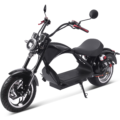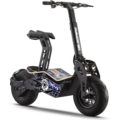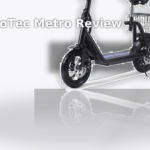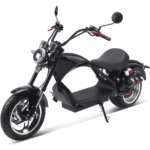- Home
- Scooters
- Electric Scooters
- MotoTec Vulcan
MotoTec Vulcan
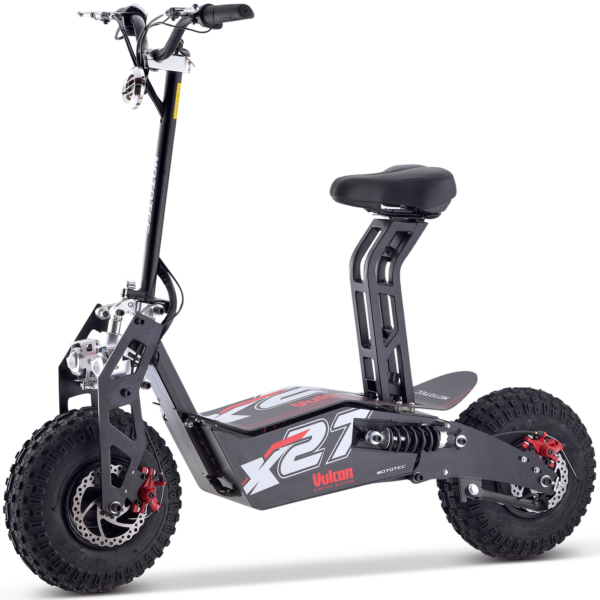

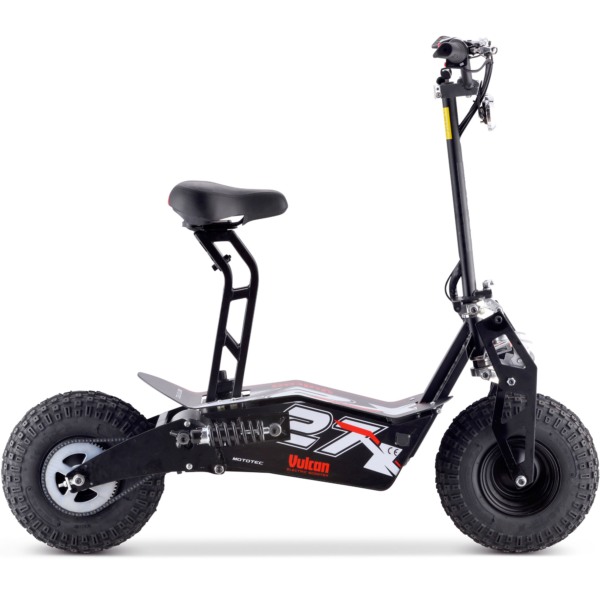

- Battery Range: 10–20 miles (16–32 km)
- Top Speed: 28–31 mph (45–50 km/h)
- Motor Power: 1600 W
- Weight Capacity: 310 lb (140.6 kg)
- Charging Time: ~4–6 h
- Scooter Weight: 143.0 lb (64.9 kg)
PROS
- 1600 W motor with strong torque
- 28–31 mph (45–50 km/h) top speed
- Front & rear disc brakes
- Front + dual rear suspension
- 310 lb (140.6 kg) rider capacity
CONS
- Very heavy at 143 lb (64.9 kg)
- Lead-acid battery pack
- Chain drive requires maintenance
- No official IP rating
- No smart/app features
Key Takeaways
- The MotoTec Vulcan is a heavy, seated electric scooter designed for stability and traction on mixed surfaces.
- It features a powerful 1600-watt motor, with a top speed of 28–31 mph and a range of 10–20 miles depending on conditions.
- The scooter’s durability comes from its steel frame and fat tires, making it ideal for suburban and recreational riding.
- Routine maintenance is essential, including charging, checking tire pressure, and inspecting the chain regularly.
- This scooter suits riders who prefer a sturdy ride, while it’s less ideal for those needing a lightweight option for stairs or tight transfers.
Table of contents
- What Is the MotoTec Vulcan?
- How the MotoTec Vulcan Works
- Key Specifications
- Design & Build Quality
- Performance Fundamentals
- Battery, Range & Efficiency
- Ride Quality & Comfort
- Braking & Safety Features
- Portability & Daily Usability
- Maintenance & Care
- Weather & Seasonal Considerations
- MotoTec Vulcan vs Alternatives
- Who the MotoTec Vulcan Is (and Isn’t) For
- FAQs
- Glossary
The MotoTec Vulcan is a seated, folding electric scooter with fat tires and real pull off the line. It runs a 48-volt system, a 1600-watt motor, and a chain final drive. This MotoTec Vulcan overview walks through how it works, what the official specifications mean on the road, and how to keep it happy day to day. The tone stays simple and friendly, so you can skim and ride.
What Is the MotoTec Vulcan?
The MotoTec Vulcan is a heavy, steel-frame scooter with a seat, dual headlights, and suspension at both ends. It targets riders who want traction and a planted feel on mixed surfaces. And it suits owners who care more about toughness than low weight.
It is not a featherweight commuter. The scooter weighs about 143 lb (65 kg), so it favors ground-floor storage or a garage. Yet it still folds, and the wide 145-mm tires add comfort on patchy pavement and hard-packed paths. Plus, the seated layout keeps longer rides easy on your knees.
How the MotoTec Vulcan Works
At the heart sits a 48-volt brushless motor rated at 1600 watts. Think of the controller as the brain. It meters power from the battery to the motor based on your throttle twist. So getaways feel smooth, and roll-on power stays predictable.
Drive goes to the rear wheel through a chain. The reduction helps torque at low speed. So the scooter pulls cleanly from a stop and holds pace on short hills. Then, once you’re moving, the motor spins in a healthy range and keeps thrust steady.
Energy comes from four 12-volt, 12-Ah sealed lead-acid batteries wired in series. That makes a 48-volt pack with about 576 Wh of nominal energy (48 V × 12 Ah). The twist throttle reads your input, and the controller ramps current to match it. Meanwhile, front and rear disc brakes handle stopping, and the dual headlights cover night visibility.
Key Specifications
Below are the official core numbers in a clean, grouped layout with imperial and metric units.
General
| Item | Value |
|---|---|
| Model | MotoTec Vulcan |
| Configuration | Seated, folding scooter |
| Recommended rider age | 13+ years |
| Max rider weight | 310 lb (141 kg) |
| Final drive | Chain |
| UL 2272 | Yes |
Performance & Power
| Item | Value |
|---|---|
| Motor | 1600 W, 48 V brushless |
| Top speed | 28–31 mph (45–50 km/h) |
| Typical range | 10–20 miles (16–32 km), rider/terrain/speed dependent |
| Drive layout | Rear wheel via chain |
| Throttle | Twist grip |
Battery, Charging & Electrical
| Item | Value |
|---|---|
| Battery type | Sealed lead-acid (SLA) |
| Battery configuration | 4 × 12 V, 12 Ah in series (48 V total) |
| Nominal energy (calc.) | ≈576 Wh |
| Charge time | 4–6 hours |
| Headlights | Yes, dual |
| Horn | Yes |
| Display | Not specified |
Build & Dimensions
| Item | Value |
|---|---|
| Frame | High-tensile steel |
| Deck | Metal |
| Suspension | Single front shock, dual rear shocks |
| Tires | 145/70-6 (approx. 145 mm width, 6-inch rim) |
| Brakes | Front and rear disc |
| Dimensions (assembled) | 52 × 25 × 46 in (132 × 64 × 117 cm) |
| Dimensions (folded) | Not specified |
| Scooter weight | 143 lb (65 kg) |
| Box size | 55 × 15 × 24 in (140 × 38 × 61 cm) |
| Box weight | 146 lb (66 kg) |
Safety & Control
| Item | Value |
|---|---|
| Front lighting | Dual headlights |
| Acoustic alert | Horn |
| IP rating | Not specified |
| Reflectors | Not specified |
Features & Extras
| Item | Value |
|---|---|
| Folding mechanism | Stem folds for storage/transport |
| Seat | Included |
| Cruise control | No |
| Economy mode | Not listed |
Warranty & Compliance
| Item | Value |
|---|---|
| Warranty | 60-day parts replacement |
| Certification | UL 2272 (electrical system safety) |
These specifications describe a sturdy, high-power, seated scooter built for stable cruising and mixed-surface rides. Plus, the layout keeps basic service simple.
Design & Build Quality
The frame uses high-tensile steel. That choice favors strength and cost over low weight. Welds are thick and practical. And the long deck leaves space for two feet in a natural stance. The metal surface wipes clean after dusty rides.
The stem locks upright and folds for storage. The latch is mechanical and easy to check before each ride. The cockpit keeps the twist throttle on the right and the power switch on the left. Then both brake levers sit close, with a short, light pull.
Fat tires in size 145/70-6 set the stance and fill the arches. They create a broad contact patch for grip on flat dirt and rough pavement. And the single front shock with twin rear shocks filter bumps you hit at neighborhood speed. Still, sharp hits come through, and you will feel them at the bars.
Fit and finish stay honest. Paint coverage looks even, hardware is standard, and cable runs are easy to trace for maintenance. Plus, the seat adds comfort when you’re out for longer loops.
Performance Fundamentals
From a stop, the Vulcan steps out with steady thrust. The 1600-watt motor gives more start-up pull than small commuter scooters. So you clear stop signs without drama. The chain reduction helps the motor stay in a healthy rpm range at low speed, and that keeps torque ready.
At 15–20 mph (24–32 km/h) the scooter feels calm and settled. The fat tires soften small cracks, and the long wheelbase tracks straight. So cruising stays relaxed on neighborhood streets. Yet steering can feel heavy in quick slaloms because the front tire has a wide footprint. Give it smooth inputs, and it rewards you with clean arcs.
On short grades in the 7–10% band, the Vulcan holds pace when you keep momentum. It is not a hill racer, but it climbs well on modest rises. Then pick smoother lines on rough patches so the chain drive rolls without extra drag.
Battery, Range & Efficiency
The 48-volt SLA pack gives about 576 Wh of nominal energy. Lead-acid chemistry likes frequent top-offs and moderate temperatures. So charge after rides and avoid deep drains. Expect more voltage drop under load than a similar-size lithium pack, and plan range with that in mind.
The listed range is 10–20 miles (16–32 km). That spread depends on speed, terrain, temperature, and rider weight. Ride at about 15 mph on flat, warm pavement and you’ll approach the high end. Push speed near the top or climb in the cold and you’ll land low. So build a buffer into your route instead of chasing the last mile.
Lead-acid packs reward routine. Keep the scooter on charge after each use, and give it a short spin at least once a month if it sits. Plus, store near room temperature to protect capacity.
Charging takes about 4–6 hours from low. The included charger is compact and simple. It shows when the pack is near full. Then give it a few extra minutes to settle before you unplug.
Ride Quality & Comfort
Ride feel comes from the wide tires, the long deck, and the twin-shock rear. On clean pavement the scooter glides and smooths out small seams. And the seat takes pressure off your knees during longer runs.
Sharp edges still get through because suspension travel is modest. So keep speed in check on broken surfaces. The stem shows a bit of the usual folding-stem flex, which takes the sting out of chatter. Still, it can add a touch of delay in rough, quick transitions. Keep a light grip and the chassis stays composed.
Tire pressure matters a lot. The sidewall lists the PSI range. Check it weekly with a good gauge. Lower pressure adds comfort but increases rolling drag and heat. Higher pressure trims drag and sharpens steering but can add buzz. So pick a middle setting that fits your weight and local roads.
Braking & Safety Features
Front and rear disc brakes give predictable stops. Pad bite comes in after about a half-lever pull, and modulation stays clear for low-speed U-turns. Set lever reach so your index and middle fingers sit on the blades while seated. Then bed fresh pads with 10–12 smooth stops from 10–15 mph.
Lighting covers the front with dual headlights. Aim them to light the near field without blinding traffic. Add a bit of passive reflectivity on your helmet or jacket for side visibility. And use a simple bell in areas with shared paths.
The Vulcan does not list ABS or electronic regen. So braking feel depends on cable health and pad condition. Keep outer housings free of kinks, swap frayed cables fast, and clean rotors if you hear squeal after wet rides.
Portability & Daily Usability
At 143 lb (65 kg), this is a roll-and-park scooter, not a shoulder-carry ride. Plan storage near ground level. Then use a ramp, not stairs, when loading into a vehicle.
The stem folds for tighter storage in a garage or shed. The deck is long and flat, so you can stand to stretch on longer rides even with the seat installed. Plus, the chain drive makes routine service easy because parts are common and access is open.
Use a quality lock through the frame or a solid anchor when you park. Start with smart location choices first. Then add a second lock if you leave it outside for long periods.
Maintenance & Care
A steady routine keeps the Vulcan smooth and safe. Follow the cadence below and you’ll catch wear early.
After every ride
- Charge the battery to full.
- Wipe the deck and chain cover to clear grit.
- Scan the tires for cuts or embedded stones.
Weekly
- Check tire pressure against the sidewall.
- Inspect brake pad thickness and cable tension.
- Check the chain for correct tension and light lubrication.
- Confirm the stem latch closes fully and sits tight.
Monthly
- Torque-check exposed fasteners on the stem, fork crown, caliper mounts, and deck hardware.
- Inspect the chain for stretch and adjust at the rear wheel as needed.
- Test lights and horn. Replace bulbs or fuses if they fail.
- Roll the scooter and listen for grinding or clicks that point to worn bearings.
Battery care basics
- Charge fully before first use.
- Charge after each ride.
- If stored, top up at least every 30 days.
- Keep storage near room temperature. Avoid heat and deep cold.
Weather & Seasonal Considerations
Water resistance is not specified, so treat the Vulcan as splash-tolerant at most. Avoid heavy rain, deep puddles, and hose-down washes. Then dry the chain and rotors if you ride through light wet.
Cold weather shortens range. SLA chemistry loses punch as temperatures drop. So keep pace moderate and charge indoors where the pack can warm. Heat also shortens battery life. Park in the shade on summer days and let the pack cool before charging.
Traction changes fast with wet leaves, paint stripes, and fine gravel. Take turns wide and smooth. Brake early, not late, on slick surfaces. And keep tires within their listed PSI range to protect grip.
MotoTec Vulcan vs Alternatives
The Vulcan sits between mainstream stand-up commuters and high-power, twin-motor rigs.
- Against light commuters: It adds torque, seat comfort, and fat-tire stability. And it trades away easy hand-carry and quick stair work.
- Against high-power dual-motor models: It weighs less than some extremes and costs less to service. Yet it will not match brutal launches or 40+ mph pacing.
- Against off-road mini bikes: It keeps floorboard comfort and a lower center of gravity. Still, it lacks long-travel suspension and true knobby tires.
If you want a lighter, sit-down city runabout, the MotoTec Metro leans toward simple errands and short hops. And if you prefer a stand-up feel with playful handling, the MotoTec Free Ride tilts toward easy fun on smooth paths.
So the MotoTec Vulcan shines for riders who want planted cruising on suburban roads and hard-pack paths, plus low-stress service with common parts. And it’s less ideal for long, steep daily climbs or tight, multi-modal commutes that demand frequent hand-carry.
Who the MotoTec Vulcan Is (and Isn’t) For
Great fits
- Suburban commuters with ground-level storage.
- Campus riders who prefer a seat and stable tires.
- Recreational riders who loop parks, bike paths, and neighborhood grids.
- Owners who want simple chain service and off-the-shelf parts.
Poor fits
- Apartment dwellers without elevator access.
- Riders who face long, steep grades every day.
- Travelers who must hand-carry onto trains or buses.
Pick it if you want a seated, stable ride that feels steady on mixed surfaces. Skip it if you need a light frame for daily stairs and tight transfers.
FAQs
How fast does it go?
The listed top speed is 28–31 mph, which is about 45–50 km/h. Real-world speed depends on rider weight, wind, and grade.
What is the real-world range?
Plan for 10–20 miles (16–32 km). Keep speed moderate and ride on flat ground to reach the high end.
Does it have cruise control?
No. The Vulcan uses a basic twist throttle without cruise features.
Is this a good “MotoTec Vulcan overview” for new owners?
Yes. It explains the parts, the numbers, and the simple care steps you’ll use most.
Can I ride in the rain?
Water resistance is not listed. Avoid heavy rain and deep puddles. Dry and lube the chain if it gets wet.
What is the battery type?
Four sealed lead-acid batteries in series make a 48-volt pack. Nominal energy is about 576 Wh.
What maintenance matters most?
Keep the batteries charged, set tire pressure weekly, adjust and lube the chain, and check bolts monthly.
Glossary
- Ah (amp-hours): Capacity measure. Higher Ah means more stored charge.
- Wh (watt-hours): Energy measure. Volts × amp-hours.
- Controller: The electronic unit that meters battery power to the motor.
- Regen: Braking that feeds energy back to the pack. The Vulcan uses mechanical discs, not regen.
- Chain drive: Power path from motor sprocket to wheel sprocket.
- Stem flex: Small movement in the folding stem under load.
- IP rating: Water and dust rating. Not listed for this scooter.
- UL 2272: Electrical system safety certification for rideables.
- PSI: Tire pressure unit in pounds per square inch.
- Lead-acid (SLA): Sealed battery type used in this scooter.
- Brushless motor: Motor design with electronic commutation for smooth torque.
- Wheelbase: Distance between front and rear wheel centers.
- Modulation: The ease of holding a steady braking force.
- Pad bed-in: Short process of seating new pads to the rotor for best bite.
- Torque: Rotational force that drives acceleration and hill starts.
Final Notes on Sizing and Use
Store the scooter near where you ride. So set routes with a little range buffer, especially in cold weather. Keep speed moderate on broken pavement. Then service the chain on a short, regular schedule, and it will pay you back with quiet miles.
Specifications
General
| Model The Model specifies the exact version or name of the scooter. It helps identify its unique design, features, and specifications within the manufacturer’s product line. Knowing the model makes it easier to compare options, find compatible accessories, or look up support information. | Vulcan |
| Brand The Brand identifies the manufacturer or company that designs and produces the scooter. A trusted brand is a sign of quality, reliability, and good customer support. Well-known brands often have higher standards for safety, performance, and after-sales service, giving you more confidence in your purchase. | MotoTec |
| Release Date The Release Date indicates when the scooter model was officially launched on the market. This helps you know how current the design, technology, and features are. A newer release date often means updated components, improved performance, and the latest safety or smart features. | 18 November 2025 |
| Recommended Age Recommended Age indicates the minimum age range that the scooter is designed for, based on safety, size, and ease of use. Following the recommended age helps ensure that riders can handle the scooter’s speed, weight, and controls comfortably and safely. Always check local laws and use protective gear, especially for younger riders. | 13+ |
Performance & Power
| Motor Power (Wattage) What it means: The motor power, measured in watts (W), shows how strong the scooter’s electric motor is. Why it matters: Higher wattage usually means better acceleration, more torque, and improved performance on hills or rough terrain. For example, a 250W motor is good for flat city roads and light riders, while a 500W or 1000W motor provides more power for faster speeds or climbing steep inclines. | Brushless motor, 1600 W (48 V) |
| Top Speed The Top Speed indicates the maximum speed that the scooter can reach under optimal conditions. It’s usually measured on level ground with a fully charged battery and an average rider weight. A higher top speed allows you to travel longer distances faster, but always ensure you ride within legal speed limits and your personal comfort zone for safety. | 28–31 mph (45–50 km/h) |
| Battery Capacity Battery Capacity refers to the total amount of energy the scooter’s battery can store, usually measured in ampere-hours (Ah) or watt-hours (Wh). A higher battery capacity means you can ride longer distances on a single charge, reducing the need for frequent recharging. Keep in mind that actual range can vary depending on rider weight, terrain, speed, and weather conditions. | 48 V 12 Ah (576 Wh) Lead-acid (4×12 V 12 Ah) |
| Estimated Range per Charge The Estimated Range per Charge indicates the average distance the scooter can travel on a single full battery charge. This range is calculated under optimal conditions, such as flat terrain, moderate speed, and average rider weight. Real-world range may vary depending on riding style, terrain, weather, and load. A longer range means fewer recharges and greater freedom for longer trips. | 10–20 miles (16–32 km) |
| Hill Climb Ability Hill Climb Ability describes the maximum incline or slope that the scooter can handle while maintaining stable performance. It’s typically expressed as a percentage or in degrees. A higher hill climb rating means the scooter can tackle steeper hills without losing too much speed or power. Actual climbing performance may vary based on rider weight, battery charge, and terrain conditions. | Not specified |
| Drive System The Drive System refers to how power from the motor is delivered to the wheels. Electric scooters typically use either a hub motor (directly integrated into the wheel) or a chain/belt drive system. A high-quality drive system ensures smooth acceleration, efficient power transfer, and low maintenance. The choice of drive system affects performance, noise level, and overall ride experience. | Chain drive (RWD) |
Charging & Electrical
| Charging Time Charging Time indicates how long it takes to fully recharge the scooter’s battery from empty to 100% using the standard charger provided. Faster charging means less downtime and more time on the road. Actual charging time may vary slightly depending on battery capacity, charger output, and environmental conditions. | Approx. 4–6 hours |
| Battery Type Battery Type refers to the specific technology used in the scooter’s battery, which affects performance, lifespan, weight, and charging time. Most modern electric scooters use high-quality lithium-ion (Li-ion) batteries because they offer a good balance of energy density, durability, and low maintenance. A reliable battery type ensures consistent power delivery and longer riding ranges. | Sealed lead-acid battery |
| Removable Battery A Removable Battery means the battery pack can be easily detached from the scooter for convenient charging and replacement. This feature allows you to charge the battery separately, swap it with a spare for extended range, or securely store it indoors in extreme weather. Removable batteries add flexibility and make it easier to keep your scooter powered up wherever you are. | Non-removable internal battery |
| Regenerative Braking Regenerative Braking is an energy-saving feature that converts some of the energy normally lost during braking back into battery power. When you slow down or brake, the motor works in reverse to generate electricity, which helps extend the scooter’s range and improves overall efficiency. This system also reduces wear on traditional brake components, leading to lower maintenance over time. | No |
| Lighting Lighting refers to the built-in front and rear lights that enhance visibility and safety when riding in low-light conditions or at night. Good lighting helps you see the road ahead and ensures that other road users can see you. Many scooters include LED headlights, taillights, and sometimes brake lights or side reflectors for added safety and compliance with local traffic regulations. | LED headlight; rear light; horn; reflectors |
Build & Dimensions
| Scooter Weight Scooter Weight refers to the total weight of the scooter when fully assembled, including the battery. This affects how easy it is to carry, lift, and store the scooter when not in use. A lighter scooter is more portable and convenient for commuting, especially if you need to carry it upstairs or onto public transport. Keep in mind that a sturdy frame and quality components may add to the weight but also contribute to better durability and ride stability. | 143.0 lb (64.9 kg) |
| Maximum Rider Weight Maximum Rider Weight indicates the highest rider weight that the scooter is designed to safely support while maintaining optimal performance and stability. Staying within this limit helps ensure reliable acceleration, braking, and climbing ability, and it protects the frame, suspension, and motor from excessive strain. Exceeding the recommended limit may reduce performance and increase wear on components. | 310 lb (140.6 kg) |
| Deck Size Deck Size refers to the dimensions of the scooter’s standing platform. A wider and longer deck provides more foot space, allowing you to stand comfortably and adjust your stance while riding. A well-sized deck improves balance and stability, especially on longer rides or at higher speeds. Compact decks, on the other hand, help keep the scooter lightweight and portable. | Seated scooter; metal deck |
| Handlebar Height Handlebar Height refers to the distance from the deck to the handlebars, which affects your riding posture and comfort. An appropriate handlebar height helps you maintain good balance, reduces strain on your back and arms, and makes steering more comfortable. Some scooters have adjustable handlebars to fit riders of different heights, while others have a fixed height for a streamlined design. | Not specified |
| Folding Mechanism The Folding Mechanism describes how easily and securely the scooter can be folded for carrying and storage. A well-designed folding system lets you quickly collapse the scooter into a compact size, making it convenient to transport on public transit, store under a desk, or fit into a car trunk. Look for sturdy latches and safety locks to ensure the scooter stays firmly in place when folded or unfolded. | Folding frame |
| Dimensions Folded Dimensions indicate the size of the scooter when it’s fully folded. This measurement shows how much space the scooter will take up when stored or carried, making it easier to check if it will fit in your car trunk, under a desk, or in a closet. Compact folded dimensions are ideal for commuters who need to bring their scooter on public transport or store it in tight spaces. | Unfolded: 52 × 25 × 46 in (132 × 64 × 117 cm); folded: Not specified |
| Material Material refers to the primary construction materials used for the scooter’s frame and key components. High-quality materials like aircraft-grade aluminum, reinforced steel, or durable composites provide strength, stability, and a lighter overall weight. A sturdy material ensures the scooter can handle daily wear and tear while maintaining safety and performance. | High-tensile steel |
Safety & Control
| Brake Type(s) Brake Type(s) describe the braking systems the scooter uses to help you slow down or stop safely. Common brake types include mechanical brakes (like drum or disc brakes), electronic brakes, and foot brakes. Many scooters combine multiple braking systems for added safety and shorter stopping distances. The type and quality of brakes affect your control, especially when riding at higher speeds or on slopes. | Front & rear disc brakes |
| Suspension Suspension refers to the system that absorbs shocks and vibrations while riding, providing a smoother and more comfortable ride over uneven or rough surfaces. Scooters may have front suspension, rear suspension, or dual suspension for better shock absorption and stability. Good suspension helps reduce rider fatigue and improves control, especially when riding on bumpy roads or off-road paths. | Single front, dual rear suspension |
| Tire Type Tire Type refers to the kind of tires the scooter uses, which directly affects ride comfort, traction, and maintenance. Common types include solid (airless) tires, pneumatic (air-filled) tires, or hybrid options. Pneumatic tires offer better shock absorption and a smoother ride on rough surfaces, while solid tires are puncture-proof and require less upkeep. The right tire type helps ensure safe handling and a comfortable ride in different conditions. | 145/70-6 (Qinda) tires |
| Tire Size Tire Size indicates the diameter and width of the scooter’s tires, which affect ride comfort, stability, and how well the scooter handles different terrains. Larger tires generally offer better shock absorption and a smoother ride over bumps and rough surfaces, while smaller tires keep the scooter lighter and more portable. Choosing the right tire size helps ensure a balance between agility and comfort. | 6-inch rim |
| Kickstand The Kickstand is a built-in stand that allows you to park your scooter upright when it’s not in use. A sturdy kickstand keeps the scooter stable and prevents it from tipping over, protecting it from scratches and damage. It also makes storing and accessing your scooter more convenient, whether you’re at home, work, or on the go. | Side kickstand |
| Water Resistance Rating Water Resistance Rating indicates how well the scooter is protected against water and moisture, usually shown as an IP (Ingress Protection) rating. This rating helps you understand whether the scooter can handle light rain, splashes, or wet roads without damage. While most scooters are not fully waterproof, a good water resistance rating adds peace of mind when riding in changing weather conditions. Always avoid deep puddles or submerging the scooter to protect its electrical components. | Not specified |
Features & Extras
| Display/Console The Display (or Console) shows important real-time information about your ride, helping you monitor your scooter’s status at a glance. Typical displays show speed, battery level, distance traveled, and riding mode. Some models also include additional features like Bluetooth connectivity, app integration, or backlighting for better visibility at night. A clear and easy-to-read display enhances safety and convenience on every trip. | Basic display/indicators (details not specified) |
| Ride Modes Ride Modes refer to the different speed and power settings you can choose to match your riding style or road conditions. Common modes include eco for maximum range and energy efficiency, standard for everyday balance, and sport or turbo for higher speed and stronger acceleration. Switching between ride modes allows you to customize performance, conserve battery, and ride safely in various environments. | Not specified |
| Smart App Connectivity Smart App Connectivity lets you pair your scooter with a dedicated mobile app via Bluetooth. Using the app, you can monitor real-time ride stats like speed, battery level, and range, adjust settings such as ride modes or cruise control, lock the scooter for added security, and sometimes receive firmware updates. This feature adds convenience and allows you to personalize your riding experience right from your smartphone. | No app |
| Anti-Theft System The Anti-Theft System helps protect your scooter from unauthorized use or theft. This feature can include built-in alarms, electronic motor locks, GPS tracking, or remote locking through a mobile app. A good anti-theft system provides peace of mind when parking your scooter in public spaces, adding an extra layer of security to safeguard your investment. | None stated |
| Cruise Control Cruise Control allows you to maintain a steady speed without continuously holding the throttle. This feature makes longer rides more comfortable by reducing hand fatigue and providing a smoother, more relaxed riding experience — especially on flat, open roads or bike lanes. For safety, cruise control can usually be easily activated or deactivated while riding. | No |
| Accessories Included Accessories Included lists the additional items that come with the scooter to enhance your riding experience and convenience. Common accessories may include a charger, kickstand, bell, lights, phone holder, or carrying strap. These extras add value by making your scooter safer, easier to use, and ready to ride straight out of the box. | Scooter, charger, tools, manual |
Warranty & Compliance
| Warranty Period The Warranty Period indicates how long the manufacturer guarantees the scooter against defects in materials and workmanship under normal use. A good warranty provides peace of mind, showing the brand’s confidence in its product quality. Always check what parts are covered, such as the frame, battery, and motor, and follow the maintenance guidelines to keep your warranty valid. | 60 days parts replacement (USA) |
| Certifications Certifications confirm that the scooter meets specific safety, quality, and environmental standards set by recognized organizations or regulatory bodies. Common certifications may include CE, RoHS, UL, or other local compliance marks, depending on your region. These certifications ensure that the scooter is manufactured to high standards and is safe and legal to use in your country. | Region-dependent |


